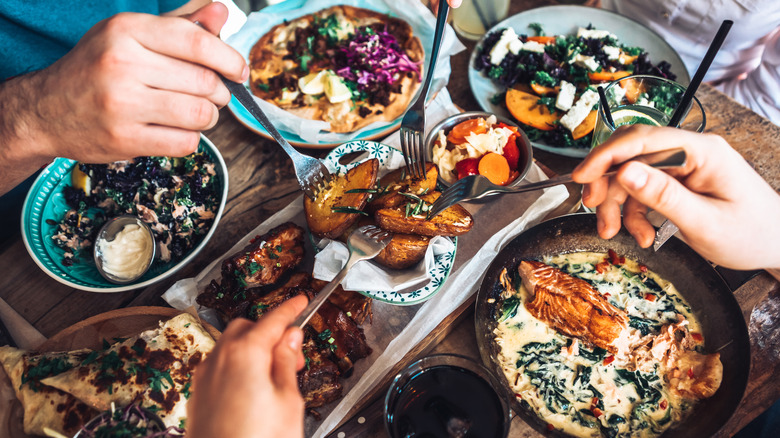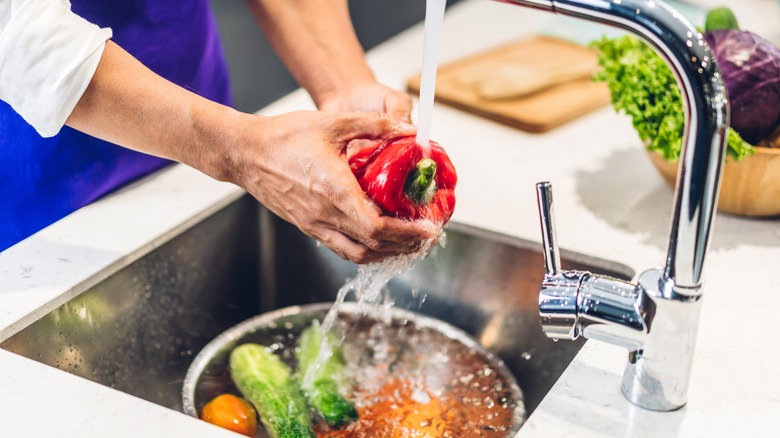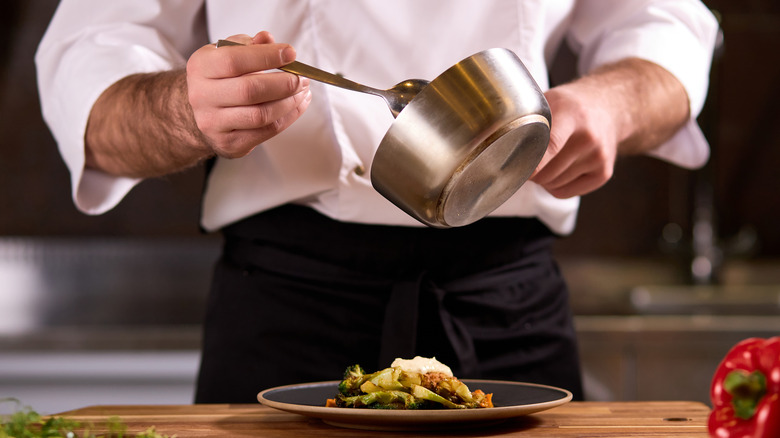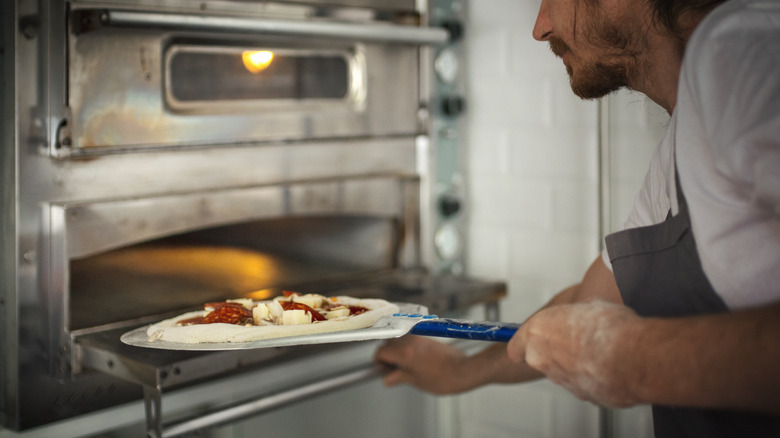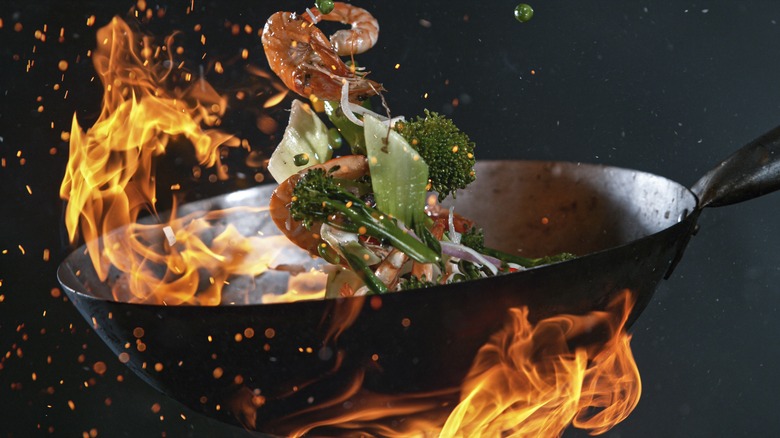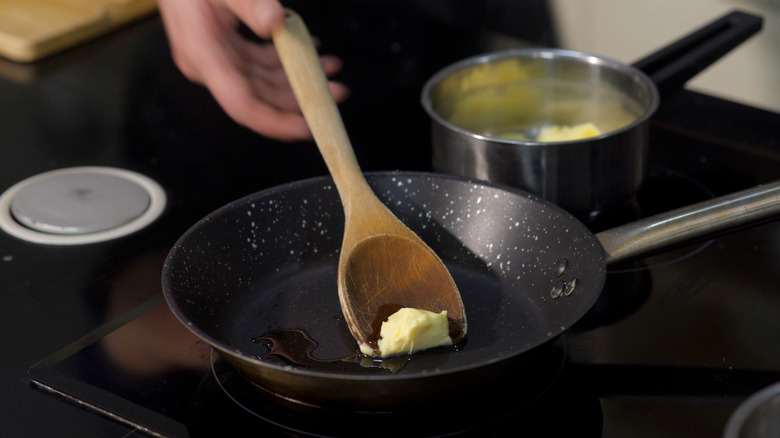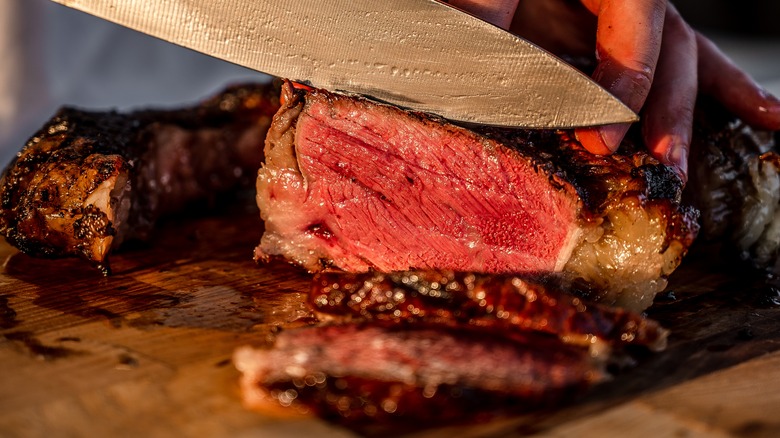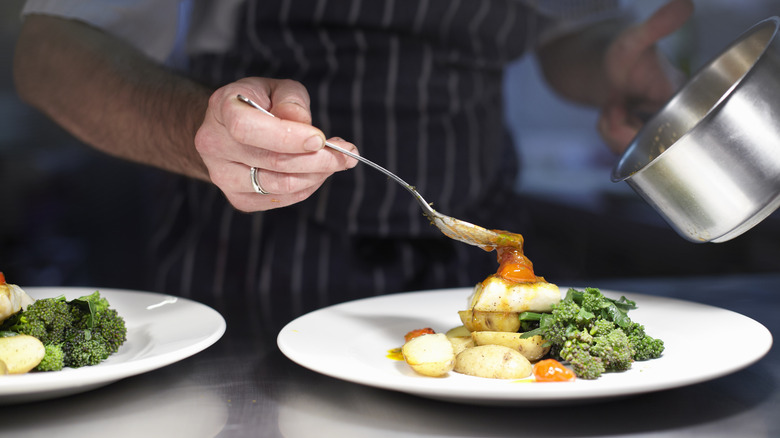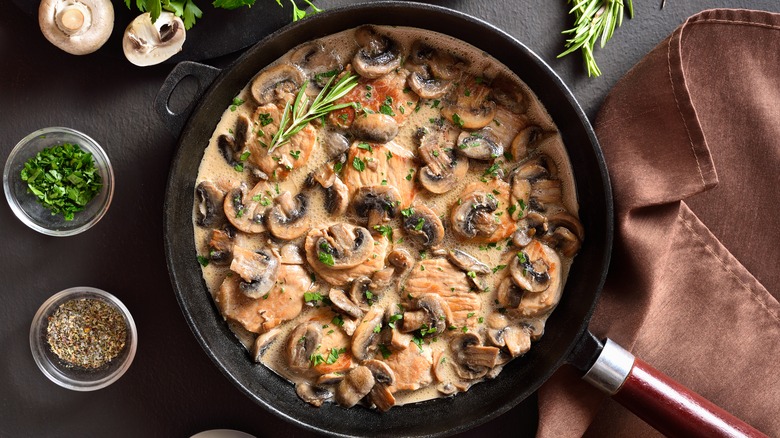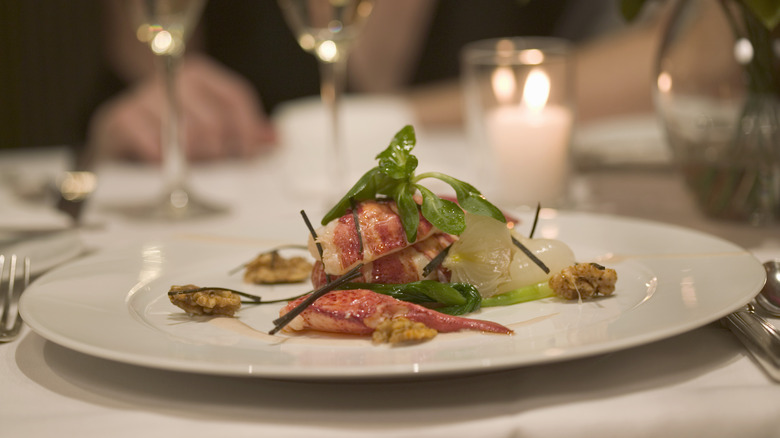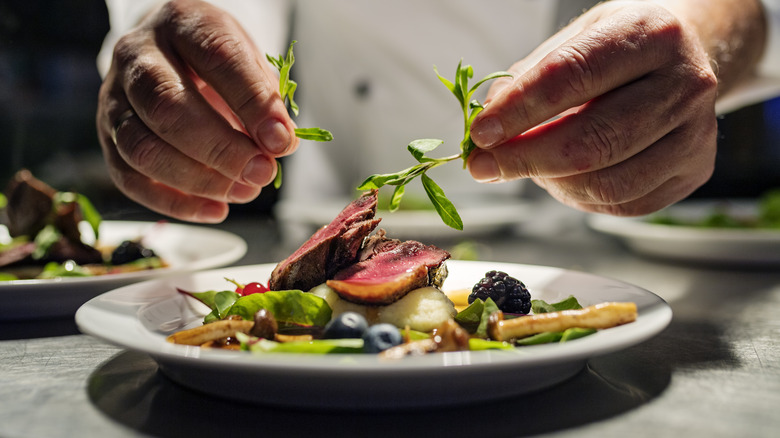12 Reasons Restaurant Food Tastes Better Than What You Cook At Home
Have you ever tried cooking your favorite restaurant meal at home? Maybe you looked up a copycat recipe of a popular restaurant's dish online and tried to recreate it, only to be let down. If so, don't take the experience personally. Many people, including those who spend a lot of time learning cooking techniques and money on quality kitchen tools, are let down when a restaurant-inspired dish doesn't have the same qualities at home. No matter how hard home cooks try, some dishes always taste better from a restaurant.
If you've been frustrated by this fact, it turns out there are many factors that impact the creation, taste, and presentation of restaurant cuisine that are hard, if not impossible, to replicate at home. We've compiled a list of the top considerations to make when you're left wondering why your home-cooked meals don't taste like the versions from your favorite restaurants.
1. Restaurants use fresh in-season ingredients
The most important factor of any dish is its ingredients, and restaurants typically prioritize their quality, freshness, and seasonality. When making meals at home, people often purchase ingredients from their local grocery store. They tend to buy everything they'll use for the week at once, meaning by the time the dish is prepared the food may be several days old.
Comparatively, restaurants usually receive daily deliveries of fresh ingredients from their suppliers. Chefs order produce, meat, and other items from high-quality providers and prioritize what is in season at any given time. This results in better-tasting dishes all around. To replicate this at home, try to buy the freshest ingredients possible and use them the same day. For example, getting leafy greens and produce from a local farmers market will make a huge difference in the taste, texture, and experience of the salads you eat at home.
2. Professional kitchens make foundational components from scratch
Although there's nothing wrong with a jar of spaghetti sauce or a bottled salad dressing, the difference between the freshly made version is truly outstanding. Think of the flavor of your favorite restaurant's salsa compared to one you buy from the grocery store, or the taste of a steakhouse salad compared to one you make at home. Seemingly small components in a dish, such as the mayo on a sandwich or the stock used in soups, can make a big impact on a meal's overall flavor.
Making these condiments and sauces from scratch is important because you can fully control the seasonings and ingredients. Chefs ensure their sauces and dressings are perfect by seasoning, tasting, and re-seasoning as needed. As a bonus, freshly made condiments and stocks tend to be lower in sodium (per Eating Well) and more affordable, especially if you only need a small amount.
To elevate your at-home salad, make a fresh dressing with red-wine vinegar, olive oil, garlic, shallots, whole-grain mustard, and honey for example. The best part is you can customize the flavors and add more or less until the dressing is to your liking.
3. Chefs season at every step of the cooking process
There's a common misconception that restaurant food tastes better because chefs use more salt than home cooks. The reality is that chefs don't use more salt, they simply use it properly. Salt (and other seasonings) needs to be incorporated during the cooking process and distributed throughout the entire dish. For restaurant chefs, this means seasoning at every step and tasting as they go to ensure each component tastes great.
Salt can help coax the natural flavor out of ingredients like vegetables and meat, while herbs and spices infuse them with additional flavors. Striking a balance between salt and seasonings is key to making your at-home meals taste as perfectly seasoned as a restaurant dish. In addition, be sure to accurately follow recipe instructions related to these add-ins, such as when a recipe calls for salted water or mentions a specific type of salt to use in a dish.
4. Restaurants have access to commercial-grade appliances and cookware
Cookware and appliances can have a big impact on the final product. Chefs have access to commercial-grade appliances like ovens, fryers, and flat-top grills at restaurants, which make cooking specific dishes much easier. In addition, they use high-quality cookware that is engineered to cook the restaurant's specialties.
There's nothing quite like the crust at a pizzeria, which features a crispy exterior, soft interior, and crunchy bottom beneath piles of sauce, melted cheese, and fresh toppings. This perfect balance of textures is achieved with high temperatures and quick cooking times. Commercial pizza ovens can reach up to 1000 degrees Fahrenheit, far above the capabilities of any home oven.
Another example is Cantonese food, known for the complex char of its stir-fry dishes. The key to this is wok hei, which translates to "breath of a wok." Wok hei is achieved by cooking food at high heat in a traditional wok seasoned with oil to prevent sticking. The combination of heat, no sticking, and the chef's skill at tossing the ingredients all creates the iconic flavor and texture of Cantonese dishes.
5. Chefs add ingredients at the right time during the cooking process
Apart from properly seasoning dishes, chefs have the advantage of knowing exactly when to add ingredients during the cooking process. For example, when cooking pad Thai, chef Andy Yang of Eat Pad Thai told the Michelin Guide that cooking the iconic dish requires a specific process to make sure the ingredients are properly integrated at the right time.
"Meat, aromatics, egg, noodles, then sauce, in that order," he said and specifies, "I suggest using a non-stick Teflon pan. Heat the pan before adding the oil, then slowly add the meat, aromatics, and seasonings. Then add eggs and noodles and stir fry for a bit before you add the sauce. Fry and toss in the pan until the sauce is evenly distributed before you remove from the heat." Each element builds on the previous one as Yang explains. When you're cooking at home, it's important to follow the recipe steps exactly as written to give you the best chance of ending up with a restaurant-worthy meal.
6. Fats are used liberally and appropriately
The great late chef and TV host Anthony Bourdain believed that butter is the reason restaurant food tastes so much better than what you eat at home. The chef even appeared on "The Oprah Winfrey Show," claiming that at least one stick of butter is present in every restaurant dish. He further explained that the purpose of the fatty ingredient was to emulsify sauces for the perfect consistency.
There's no denying that butter is a great ingredient and it shouldn't be feared when cooking at home, but that doesn't mean drenching your dishes in butter will solve all your problems. Like any ingredient, it should be used thoughtfully to achieve the best result. A simple step like making compound butter is a chef-approved hack for upping the flavor profile of protein.
Besides butter, oils are essential to any restaurant dish. Adding oil to your vegetables and proteins increases the surface temperature of the ingredients as they cook. This gives them more opportunity for browning, which is the key to providing extra flavor.
7. Protein is cooked to perfection
Dining at a steakhouse or gourmet restaurant is guaranteed to provide you with a deliciously juicy cut of meat. It takes practice to cook the perfect piece of protein, and chefs have it down. That's why some protein-based dishes simply taste better at a restaurant. Any home cook worth their salt has experienced the frustration of spending hours in the kitchen only to ruin a dish by overcooking the meat until it's dry and nearly flavorless.
If you're not using a meat thermometer, you could be drying out your protein without even knowing it. To avoid overcooking your meat, use a digital thermometer to measure the doneness. Steak, for example, should reach an internal temperature of 120, 140, or 160 degrees Fahrenheit respectively, for a rare, medium, and well-done preparation, according to grilling expert David Rose (via Insider). He recommends undercooking the meat by about five degrees since it continues to cook once you take it off the heat.
Meanwhile, chefs and TV personalities Cat Cora and Richard Blais told Insider that cooking fattier proteins, like pork or a whole chicken, can minimize at-home protein disasters since the fat content helps the meat stay moist.
8. Restaurant dishes have a good balance of flavors
Before your plate hits the table at a restaurant, it was first conceived by a professional chef as an idea for the menu and practiced repeatedly. This results in a distinct balance of flavor achieved by thoughtfulness and trial and error. But achieving a perfectly balanced dish doesn't have to be reserved for professional chefs. Being more deliberate about the flavor combinations you layer into a dish, and balancing ingredients so it's not too sweet, salty, spicy, or bitter, can make all the difference.
Chef and TV host Carla Hall told Insider that home chefs can achieve delicious dishes simply by thinking about how the ingredients work in harmony. She notes the distinction between complementary and contrasting flavors, using a chocolate coffee cake to demonstrate. While the warm flavors of cinnamon blend with the chocolate, orange would stand out as a bright element.
9. Chefs are trained to successfully execute difficult dishes
It's said that practice makes perfect and cooking is no exception. Chefs have put in countless hours honing their craft, so if you're not a professional don't be too hard on yourself when a restaurant dish tastes so much better than what you make at home.
For example, in an interview with Insider, Food Network star and Charm City Cakes owner Duff Goldman explains that something as simple as a pie can be quite tricky to make since a series of steps need to happen a certain way. For Goldman, who has worked in pastry every day of his career, making a homemade pie would be much easier than for anyone baking for the first time.
Another factor to consider is the type of cooking you're used to doing. If you don't have much experience with Chinese food, methods such as stir-frying, steaming, and red stewing might be difficult to approach. If something is not in your cooking repertoire, it will always taste better when you eat it at a restaurant that specializes in that cuisine.
10. Umami-rich ingredients are commonly used in restaurant cooking
When you think of restaurant food and that special something that professionally cooked dishes have, you could be thinking of umami, a Japanese term for savoriness. Like sweet, salty, sour, and bitter, umami is a dynamic and distinctive flavor profile that can instantly sell a dish. Restaurants know this and as a result, tend to incorporate a variety of umami-rich ingredients into their dishes.
Common examples include roasted garlic, mushrooms, soy sauce, anchovies, MSG, miso, aged cheese, and more. These flavors add layers to a dish and keep diners coming back for more. Try including more umami-based ingredients in your home cooking to help elevate your meals. This can be as simple as sprinkling freshly grated Parmesan cheese on top of an easy pasta dish or as complex as creating your own homemade pastes from mushrooms or anchovies to add to dishes.
11. People perceive expensive food as tasting better
Unfortunately, it's true — sometimes restaurant food may seem like it tastes better simply because you paid more for it. In 2014, researchers at Cornell University performed an experiment at an Italian buffet in which two sets of customers were offered different pricing (via The FASEB Journal). One group was charged $4 to eat at the buffet while the other was offered access for $8. When asked to rate their dining experiences, the $8 group enjoyed their meal more than the lower-cost group.
Another example of cost affecting the perception of food's overall taste and quality occurs with stunt foods, which are essentially wild dishes that are purposefully created to generate buzz. Stunt foods with more prestige, like the Cronut, are often perceived as a decadent treat worth the price tag. Meanwhile, cheap items from fast-food restaurants, like KFC's Double Down, garner a reputation as a greasy over-the-top creation. Both are over-indulgent and inherently unhealthy, but one costs more than the other and has a higher reputation — in the case of the Cronut probably due to its European flair.
12. Diners think food tastes better if it's presented in an appealing way
There's nothing like being served a gorgeous dish on a pristine plate with just the right garnishes placed delicately on top. Yes, it looks beautiful and it certainly makes for great social media content, but does a well-presented visually appealing dish actually matter all that much? As it turns out, yes. Eating food you've cooked at home may be lackluster because it's not as well presented as restaurant dishes.
In fact, Charles Spence, a professor of experimental psychology at Oxford University, has made a career out of running experiments proving that presentation can change how someone perceives the taste of food. One of his many experiments proved that coffee tastes almost twice as intense when drunk from a white mug rather than a clear glass one (via The New Yorker). The discovery that what people see on their plates affects how food tastes has been replicated in many studies. So, the next time you're cooking at home, think twice when plating your dish. Some extra care in the presentation may make all the difference.
